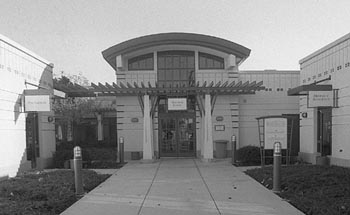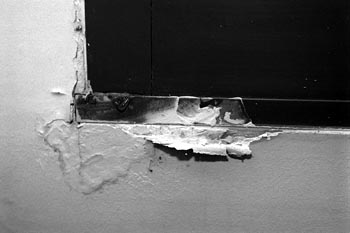![[Metroactive News&Issues]](/gifs/news468.gif)
[ Metro | Metroactive Central | Archives ]
Slime and Punishment
Keystone Courthouse: San Martin's new courthouse has been cordoned off in places while health officials try to figure out what can be done about a potentially harmful greenish-black mold growing around windows and cracks.
Green mold is eating its way through San Martin's new courthouse, but figuring out who's to blame is a slippery matter indeed
By Justin Berton
AS A SANTA CLARA COUNTY deputy public defender, Enrique Colin has plenty of experience working with slime. In his years on the job, he's met the seedier members of society, and he's had to defend their rights in a court of law. But inside the defender's office, located in the south county courthouse in San Martin, Colin not only defends slime, he also works alongside it.
The slime, which in this case takes the form of a gooey greenish-black mold, has invaded the 3-year-old building, much to the horror of city officials and health workers, who say it can be dangerous.
Employees such as Colin can peek into windows of sealed-off rooms and see sheets of plastic covering up the festering fungi.
"I might think it was more of a serious problem if I saw big black spots on the wall," Colin jokes.
But the mold, even though Colin and others can't see it up close and personal, has become a serious problem for Santa Clara County. As health technicians continue to take samples from the affected areas, and employees continue to work daily at the courthouse, an end to the problem hardly seems to be on the horizon.
Caught up in uncertainty over who's responsible for the mold infestation and whether it presents any hazards, users of the courthouse--and the county taxpayers who shelled out $6 million for the swanky structure--aren't tickled pink about the green menace.
Tucked in between Gilroy and Morgan Hill, San Martin is a quiet farming community along the Monterey Highway. Save for a few million-dollar residential palaces that dot hilltops overlooking the farms, the south county courthouse is the classiest piece of architecture in town.
So classy, it seems, it is not called merely a courthouse, but rather the "South County Justice Center."
The center, stylishly painted tan and off-tan, is snappily tiled and well lit. After completion of the building in January 1995, the required "post-occupational evaluation" that follows all county projects was conducted. Gushing employees gave the structure the highest rating ever received by a county construction project.
But since that time water has seeped in, mainly around the windows, saturating the sheet rock and allowing slimy fungi to form. And the problem, no matter which participant one talks to, is the fault of someone else. Those who constructed the building say it is a design problem; designers call it a construction problem. Nobody (except the health department) wants to think it presents a serious health problem, and everybody concedes the whole thing is a slippery mess.
LANI LEE, ACTING DIRECTOR of occupational safety and environmental compliance for the county, says the invader's motion, in terms of health risks, has been quashed.
"The first time we went in and monitored the air, there were high levels of mold," Lee admits. "More than outside the building."
Though Lee says there is no standard for how much airborne mold represents a hazard, her department knew enough to take drastic measures upon discovery of the slime in February.
Crews covered the spreading goo with sheets of plastic to keep the spores from taking to the air and landing inside human lungs, where they can cause irritation. They roped off four rooms and hung "No admittance" signs on the doors.
"Nobody," Lee boasts, "was allowed in those rooms."
Then Lee called Michael Fischman, a leading occupational and medical physician, who teaches at UC-San Francisco.
"Typically, mold doesn't get into the air unless it is disturbed--which didn't happen," Fischman recalls.
But Fischman, who was hired to review the results gathered by the technicians, says defining academic conclusions have not been drawn about what type of health risk the mold could pose if ingested by humans.
Fischman speculated that were the spores to attack adults working in the building, the afflicted would feel some irritation while inhaling and would experience flu-like symptoms. Some might have difficulty breathing and--at the extreme end--suffer respiratory failure.
But Fischman stresses that "it's kind of speculative as to what it would do."
"It does not look like," Fischman says, emphasizing the unknown, "under certain circumstances, it could be hazardous to the health."
He adds, "There continues to be quite a controversy" in academic circles.
For Lee and the county, though, the health controversy has ended. Mold abatement procedures have commenced, and two rooms that were once quarantined are now open.
But until all the mold is removed--and no one seems to know when that will be--Lee remains careful not to underestimate the determination of the spreading growth.
"There are so many areas where the mold is growing," Lee says. "Just because you can't see it doesn't mean it's not there."
Spore Rooms: Mold flourishes around windows and cracks in the San Martin justice center.
'IT IS A DESIGN ISSUE, not a construction issue," says Ernie Szabo, a principal partner in H.A. Ekelin, the contractor the county hired for the project.
Szabo says he would be more than happy to remedy the situation--if a conclusive study were to suggest his company was responsible.
"We have made several requests for copies of this study," Szabo complains. "But we have seen nothing. We asked, through our attorney, if there was anything we can do. Because if there were, we would want to take care of it."
Szabo says that, as he understands it, the problem is in the placement of the exterior insulation finishing system, or EIFS, a commonly used Styrofoam-based filler that coats buildings. Szabo says poor design could have led workers to install the EIFS incorrectly near the windows, where most of the leaks have been discovered.
Once the water seeps in, it saturates the sheet rock; then mold spores nest. In the case of the San Martin Justice Center, the slime grew to proportions large enough to show its ugly, gooey face.
This face, say designers for the San Francisco-based Kaplan McLaughlin Diaz, is not of their creation either.
Christina Feller views her company, KMD, as saviors of the justice center and deserving of the credit for elevating it into the gorgeous facility it is.
Before KMD took on the project in the late stages, Feller says, a firm in Sacramento was fired by the county for turning in shabby designs and operating at 30 percent over budget.
"When we came in," Feller says, "it was like, 'Help! Do something quick!' "
Feller compliments the building as one of the finest structures in the county, and certainly in San Martin.
But since the slime appeared, KMD has been on the defensive.
"We've had a very unwanted finger of blame pointed directly at us," Feller says.
To combat the attacks, the company issued a disclaimer refusing responsibility for the slime, reasoning that it is not responsible for the leaks.
As a result, Feller says, KMD has been the victim of industry bad-mouthing.
"Now, all of our references are being checked. I'm not going to name names," she says, "but in this industry, it doesn't surprise me."
When told of Szabo's comments that it was a "design issue, not a construction issue," Feller lets out a grunt.
REGARDLESS OF who is to blame, one thing remains clear: county taxpayers are stuck with a $6 million courthouse that-- should the mold problem worsen--could require a complete overhaul.
Costs of abatement and potential reconstruction to plug the leaks will remain unknown until workers conclude how much mold is present. Presiding Judge Jack Komar says a comprehensive study of the facility is under way and should conclude in the spring of 1999.
Lee says her department will continue to chip away at the abatement process but must first determine where all the leaks are and how much mold exists. Szabo says he hasn't heard a thing from the county in months and therefore understands the issue to be dead. Feller and her company cling to a disclaimer of responsibility and point to the high marks from the post-occupational evaluations as proof that KMD saved the county from an overbudget white elephant.
The word "lawsuit" hovers in the office of the county counsel, but has yet to be vocalized using the words "South County Justice Center." Komar says the issue remains open and in pre-litigation, meaning information is still being gathered to determine if a lawsuit will be pursued.
As for Colin, the deputy public defender, says he will happily work with both types of slime that pass through the justice center.
He says fellow employees have not been told when the situation might clear up and the extra rooms reopen.
"We all accept it as working for government," Colin says.
[ San Jose | Metroactive Central | Archives ]
![]()

Larry Brazil
Larry Brazil
From the December 17-23, 1998 issue of Metro.